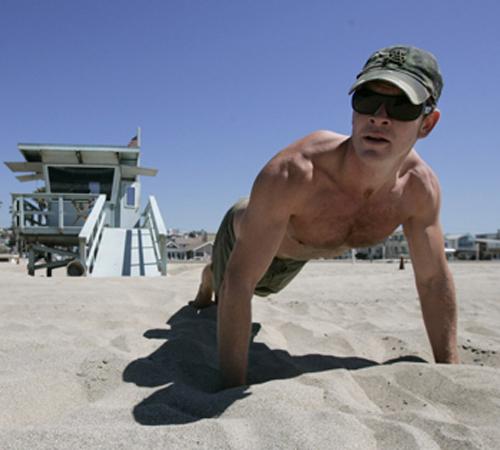Life’s a beach for those who guard it

May 29, 2008
MANHATTAN BEACH, Calif. — Eric Atkeson’s eyes dart across a sun-drenched stretch of beach, looking for ever-so-slight signs of trouble. His gaze fixes on three young boys splashing around in the water, just a bit farther out than he’s comfortable with.
His words trail off in mid-sentence and suddenly he’s making a beeline for the boys and an adult near them. One lecture later and the boys have migrated a little closer to shore.
Atkeson, 51, heads back to his lifeguard tower at Manhattan Beach, weathered crows feet smiling at the corners of his eyes.
He’s a lifeguard, and he’s done this a few times.
Atkeson could have stopped guarding the beachgoers years ago, packed up his flip-flops and headed towards retirement.
Get The Daily Illini in your inbox!
But he and many of his colleagues at the nation’s biggest and busiest lifeguard operation in Los Angeles County can’t seem to pull themselves away from the waterfront.
“I grew up here. This is my family. We’re all brothers and sisters here. It’s just a way of life,” Atkeson says.
In between push-ups and sit-ups and brisk swims in the Pacific, lifeguards like Atkeson get busier with rescues as summer approaches. They’ll ramp up the number of bodies in the towers to keep pace with the frolickers on the beach and in the water.
“For a lot of us, we love the beach so much that we found a way to make a living at the beach,” Atkeson says. “And it keeps us in shape. A lot of the old retired guys, they live for a long time.”
The Los Angeles County Lifeguard Service is operated by the fire department, which emphasizes a level of professionalism above and beyond the vehicle by which most of the public knows them best, the television series “Baywatch.”
Lifeguard Capt. Terry Harvey, a spokesman for the vast operation – there are 181 permanent lifeguards and 758 seasonal lifeguards – says the impact of the show was a double-edged sword.
“It did good and bad for us. It basically put a big spotlight on our occupation and what we do. And then again it also gave an image, a nonprofessional image I want to say, about what we do in our occupation,'” Harvey says.
What was that “bad” image? The lifeguard as a laid-back makeout artist hitting on girls in bikinis and working on his tan all day, for the most part. The reality of an L.A. County lifeguard is decidedly different.
“Slackers need not apply,” Harvey says.
There are vigorous workouts throughout the day. A few sit-ups here, some abdominal crunches there, wind sprints up and down a firm stretch of beach. It breaks up the monotony, keeps everyone in shape and keeps the lifeguards aware of the surroundings.
A sly but strong rip current is easier to spot if you actually taking a swim once an hour.
The lifeguards also keep an eye peeled for surfers and boogie boarders in distress. There are little signs, imperceptible to most, that are dead giveaways for experienced lifeguards.
Theresa Connelly, a lifeguard with 18 years of experience, watches intently from the corner of a large watch station along Manhattan Beach. She spots a boogie boarder pulling a couple of rookie moves in the water.
“Your eyes automatically just focus in on it because you sort of notice the level of competency. No wet suit. No fins. You kind of deduct that they’re not going to be the best boogie boarders around,” Connelly says.
Even experienced surfers looking for a nice break can get themselves in trouble and require saving, says Lifeguard Capt. Greg Lee.
Many of the lifeguards surf for fun when they’re not working. There are several generations of lifeguards that make their way through the department. Old photographs dating back to the 1940s dot the walls inside the lifeguard stations.
The county’s lifeguard operation makes an estimated 10,000 rescues a year and the beaches host 60 million visitors annually.
Many of the lifeguards like Lee have made a career out of it. He’s been a lifeguard since 1980 and employed year-around since 1986.
“Well, the lifestyle is awesome,” Lee says. “I see my neighbors getting ready to go to work in the morning and going out to their cars and they have suits and ties on and I’m walking out to my car at just about the same time and I have shorts and sandals on, a T-shirt, and my most valuable piece of equipment are my sunglasses. And they just look at me like ‘Are you working today?'”
His job that day may be to save them.






